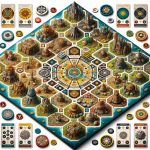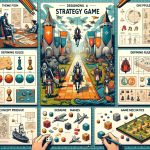Are you ready to design your own strategy board game? Strategy board games have been gaining popularity in recent years, offering players a unique and engaging gaming experience.
In this article, we will explore the growing popularity of strategy board games and provide a step-by-step guide on how to create your very own game. From understanding the basics of what defines a strategy board game to choosing the right theme and concept, we will cover everything you need to know to bring your game idea to life.
Strategy board games have become increasingly popular among both casual and serious gamers, providing a mentally stimulating and competitive gameplay experience. Whether it’s conquering new territories, managing resources, or outwitting opponents, these games offer a wide range of strategic challenges for players to enjoy. With the rise of tabletop gaming culture, there’s no better time than now to unleash your creativity and design your very own strategy board game.
In the following sections, we will provide a comprehensive guide on how to design your own strategy board game. We’ll cover everything from conceptualizing an engaging theme and implementing strategic gameplay mechanics to testing and prototyping your game idea.
By the end of this article, you’ll have the tools and knowledge needed to craft a unique and compelling strategy board game that can captivate players for hours on end. So get ready to dive into the exciting world of game design as we explore the creative process behind crafting your very own strategy board game.
Understanding the Basics
Strategy board games are a popular form of entertainment that requires players to use strategic thinking and decision-making skills to achieve victory. But what exactly defines a strategy board game?
In essence, a strategy board game is a game that focuses on skillful thinking and planning, often with little to no element of luck involved. These games typically involve players competing against each other in a battle of wits, with the outcome determined by their strategic choices rather than chance.
One defining characteristic of strategy board games is the importance of long-term planning and foresight. Players must anticipate their opponents’ moves while also considering their own future actions in order to secure an advantageous position. This element of strategic depth sets strategy board games apart from other types of board games, such as party or trivia games, which often rely more heavily on luck or spontaneous decision-making.
Another key feature of strategy board games is the emphasis on resource management and optimization. Whether it’s controlling territory, gathering resources, or amassing power, these games require players to make efficient use of limited assets to outmaneuver their opponents. This adds another layer of complexity and challenge to the gameplay, making strategy board games rewarding for those who enjoy deep thinking and tactical planning.
With the rise of tabletop gaming in recent years, there has been a surge in interest in designing and creating custom strategy board games. If you’re passionate about game design or simply want to try your hand at creating your own unique game experience, understanding the core elements of what makes a successful strategy board game is essential.
| Strategy Board Game Characteristics | Description |
|---|---|
| Strategic Depth | Requires long-term planning and anticipation of opponents’ moves. |
| Resource Management | Emphasizes efficient use of limited assets for optimal advantage. |
Step-by-Step Guide
Creating a strategy board game can be a rewarding and fulfilling experience. Whether you’re a game enthusiast looking to bring your ideas to life or a newcomer to the world of game design, following a step-by-step process can help you navigate the complexities of creating your own game. In this section, we will provide you with essential guidelines on how to design your own strategy board game.
Concept and Theme Development
The first step in designing your own strategy board game is to develop a unique concept and theme. Consider what type of experience you want to create for players – whether it’s a medieval battle, space exploration, or political intrigue. Your theme will set the tone for the entire game and help shape its mechanics and aesthetics.
Mechanics and Game Rules
Once you have established your theme, it’s time to delve into the mechanics and rules of your game. This involves determining how players will interact with the game components, win conditions, turn structure, resource management, and more. Designing strategic gameplay elements that promote critical thinking and decision-making is crucial for a successful strategy board game.
Testing and Prototyping
After conceptualizing the theme and mechanics of your game, it’s important to create a prototype and test it extensively. Prototyping allows you to experiment with different gameplay ideas, tweak rules, balance mechanics, and ensure that the overall experience is engaging for players. Gathering feedback from playtesters will also help identify areas for improvement before moving forward with production.
By following these fundamental steps in designing your own strategy board game – developing a unique concept and theme, crafting strategic gameplay elements, prototyping and testing – you’ll be well on your way to creating an immersive gaming experience that reflects your vision as a designer.
Choosing the Right Theme and Concept
One approach to choosing the right theme is to consider popular trends and interests within the gaming community. Whether it’s fantasy, historical, sci-fi, or even a unique blend of genres, identifying a theme that appeals to a specific audience can help garner interest in your game. Additionally, leveraging current events or cultural phenomena can also provide inspiration for a captivating theme that resonates with players.
In addition to the theme, developing a compelling concept for your strategy board game is equally important. The concept should encompass the core mechanics of the game, including win conditions, player interactions, and strategic elements.
Whether it’s resource management, area control, or hand management, defining the concept early on will guide the development of your game mechanics and rules. By fleshing out a solid theme and concept for your strategy board game at the onset of the design process, you can effectively captivate potential players and distinguish your game from others in the market.
Game Mechanics and Rules
When it comes to designing a strategy board game, the game mechanics and rules are essential elements that can make or break the overall gaming experience. The mechanics of a game refer to the actions and processes that players can take within the game, while the rules dictate how these mechanics are implemented and enforced. In order to create a successful strategy board game, it is crucial to carefully consider and fine-tune these aspects.
One of the key considerations when implementing game mechanics is balance. A well-balanced game ensures that no single strategy or approach dominates the gameplay, creating a more engaging experience for all players. This can be achieved through thorough playtesting and iteration, as well as thoughtful consideration of how different mechanics interact with each other.
In addition to balance, it is important to consider the depth of strategy within the game. Strategic gameplay elements should provide players with meaningful choices and decisions to make throughout the course of the game. This can include resource management, player interactions, and multiple paths to victory. By integrating these strategic elements into the game mechanics and rules, players are more likely to stay engaged and invested in the gameplay experience.
Ultimately, successful implementation of strategic gameplay elements requires careful thought, testing, and iteration. Whether it’s through drafting cards in a deck-building game, managing resources in an economic simulation, or planning tactical moves on a modular board, each strategic element should contribute to an enjoyable and challenging gaming experience. By taking the time to carefully design and implement these elements, aspiring game designers can create unique and compelling strategy board games that resonate with players.
Prototyping and Testing
Once you have a solid concept for your strategy board game, it’s time to bring it to life through prototyping and testing. This crucial step in the game design process will help you refine your ideas, mechanics, and rules to ensure an enjoyable and strategic gameplay experience for players. Here’s a step-by-step guide on how to effectively prototype and test your game:
1. Create a rough prototype: Start by putting together a basic version of your game using materials such as paper, cardboard, or inexpensive components. This allows you to quickly iterate on different ideas without investing too much time or resources.
2. Test with friends and family: Gather a group of playtesters to try out your prototype. Observe how they interact with the game, take note of any confusion or areas of improvement, and gather feedback on their overall experience.
3. Refine and iterate: Based on the feedback from playtesting, make necessary adjustments to the game mechanics, rules, and components. Keep refining and iterating on your prototype until you feel that the gameplay is engaging and strategic.
4. Blind playtesting: Once you’re confident in the core mechanics of your game, conduct blind playtests where you provide minimal instruction to new players. This will help identify any ambiguities in the rules or components that need further clarification.
By following these steps, you can effectively bring your strategy board game to life through prototyping and testing. Embrace the valuable feedback from playtesters as an opportunity to refine and improve your game before moving onto the next stage of production.
Remember that prototyping is an iterative process, so don’t be discouraged by initial setbacks or challenges. With dedication and perseverance, you can create a compelling strategy board game that captivates players with its strategic depth and engaging gameplay experiences.
Art and Design
Visual Style and Theme
When it comes to designing a strategy board game, the visual appeal is crucial in capturing the attention of potential players. The first step in crafting visual appeal for your game is to determine the overall visual style and theme.
Whether you opt for a fantasy world, historical setting, or futuristic theme, it’s important to ensure that the art and design elements align with the concept of your game. Consider creating a mood board or collage of visuals that inspire your game’s aesthetic to give you a clear direction for its art and design.
Components and Materials
Another aspect of art and design in strategy board games is the selection of components and materials. From game board and cards to tokens and player pieces, each component should be thoughtfully designed to enhance the overall gaming experience.
Consider the materials used for these components, as well as their durability and tactile appeal. The design of these components can greatly impact how players engage with your game, so it’s essential to pay close attention to their visual and functional aspects.
Illustrations and Graphics
In addition to selecting a visual style and designing components, incorporating illustrations and graphics can elevate the overall aesthetic of your game. Whether you choose to work with an illustrator or create your own artwork, the illustrations on cards, boards, and other components should be cohesive with the theme while also being visually engaging. Consistent art style throughout your game will not only contribute to its visual appeal but also reinforce its identity as a cohesive experience for players.
By paying careful attention to visual style and theme, selecting high-quality components, materials, incorporating captivating illustrations, you can craft an immersive gaming experience that will make your strategy board game stand out in today’s market.
Remember that successful games captivate players not only through strategic gameplay mechanics but also through captivating visuals that draw them into the world you’ve created.
Launching Your Game
Once you have finished designing your own strategy board game, the next step is to consider how you will bring your creation to the public. Launching a game involves strategic planning and marketing efforts to ensure that it reaches its intended audience. Here are some strategies for marketing and distribution that can help you get your game into the hands of eager players.
One key strategy for launching your game is to utilize social media and online platforms to create buzz around your product. This can include creating engaging content such as gameplay teasers, behind-the-scenes looks at the design process, and interactive posts that involve potential players in the development of the game. You can also use social media to connect with gaming communities and influencers who can help spread the word about your game.
Another important aspect of launching a game is determining the best distribution channels for reaching your target audience. Whether it’s through online marketplaces, retail partnerships, or direct sales through your own website, choosing the right distribution method can greatly impact the success of your launch. It’s also essential to consider factors such as packaging design, pricing strategies, and fulfillment logistics when planning how to get your game into the hands of consumers.
In addition to online and retail distribution, attending board game conventions and events can be a powerful way to generate interest in your game. These gatherings provide an opportunity to showcase your creation, gather feedback from players, network with industry professionals, and even secure partnerships with distributors or retailers. By engaging with the gaming community in person, you can build awareness for your game while also gaining valuable insights for future iterations or expansions.
| Launching Your Game Strategies | Benefits |
|---|---|
| Social Media and Online Platforms | Creates buzz, connects with influencers |
| Distribution Channels | Reaches target audience effectively |
| Board Game Conventions | Generates interest, gathers feedback |
Conclusion
Game design is an art that requires a lot of creativity and innovation. The process of designing your own strategy board game can be both challenging and rewarding. It allows you to create a unique game experience that can bring people together and provide hours of entertainment. Whether you are a seasoned game designer or a newcomer to the world of board games, there are several key steps to keep in mind when embarking on this creative journey.
One important aspect of designing your own strategy board game is choosing the right theme and concept. This will set the tone for your game and help determine its overall appeal. Consider themes that resonate with your target audience and create a concept that offers something fresh and exciting. Some popular themes for strategy board games include fantasy, historical, sci-fi, and more.
Once you have established your theme and concept, it’s time to focus on the game mechanics and rules. These elements are crucial in shaping the strategic gameplay experience. Think about the dynamics of interaction between players, the balance of luck versus skill, and how strategic decision-making will come into play. Creating clear and concise rules is also essential for ensuring an enjoyable gaming experience for all players.
Another important aspect of game design is prototyping and testing. This involves creating rough versions of your game, known as prototypes, to test its mechanics, balance, and overall fun factor. Incorporate feedback from playtesting sessions to refine your game further before finalizing it for production. This iterative process will help you identify any flaws or areas for improvement before launching your game into the market.
Bonus Tips and Resources
In conclusion, designing your own strategy board game can be a fulfilling and rewarding experience. By understanding the basics of what defines a strategy board game and following a step-by-step guide, anyone can create their own unique game. It’s important to choose the right theme and concept to provide a one-of-a-kind experience for players, and to implement strategic gameplay elements to keep them engaged.
Prototyping and testing are crucial steps in bringing your game to life, ensuring that it is enjoyable and balanced. Paying attention to art and design is also important for crafting visual appeal that will attract players. Once your game is ready, there are various strategies for marketing and distributing it effectively.
In the end, embracing the creativity and innovation of game design is key. With the bonus tips and resources provided by experts in the field, as well as using the right tools for game design success, aspiring game designers can bring their vision to life. Designing your own strategy board game offers limitless possibilities for creativity in an ever-growing industry.
Frequently Asked Questions
How to Design a Strategy Game?
Designing a strategy game involves first determining the theme, setting objectives, and creating rules. It’s important to consider the target audience and ensure a balance between challenge and enjoyment.
How Do I Design My Own Board Game?
Designing your own board game requires brainstorming unique gameplay mechanics, creating a compelling theme, designing the game board and pieces, playtesting extensively, and refining the game based on feedback.
How to Make a Model of a Board Game?
Making a model of a board game involves sketching out a rough prototype of the board and pieces, testing different layouts and designs, getting feedback from playtesters, making necessary adjustments, and creating a final version for production.

I love playing all kinds of games – from classics like Monopoly to modern favourites like Ticket to Ride.
I created this blog as a way to share my love of board games with others, and provide information on the latest releases and news in the industry.





